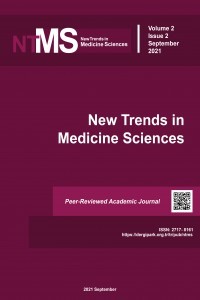Characteristics Of Post-Tonsillectomy Hemorrhage Patients And Our Approach To These Patients
Characteristics Of Post-Tonsillectomy Hemorrhage Patients And Our Approach To These Patients
Background/Aim: Tonsillectomy is one of the most common operations performed by Otorhinolaryngologists (Ear Nose Throat, ENT) in practice and can lead to important complications. Post-tonsillectomy hemorrhage is one of the major complications. The aim of the study was to present the characteristics and treatment approaches of patients who were admitted to our clinic with post-tonsillectomy hemorrhage, followed-up and treated.
Methods: Patients who applied to Otorhinolaryngology Clinic of our hospital between January 2014 and December 2020 with complaints of bleeding from the tonsil after tonsillectomy were included in this study. Patient files and hospital automation system were reviewed retrospectively
Results: A total of 634 tonsillectomy operations were performed in our clinic between 2014 and 2020. Of these, 34 patients had post-tonsillectomy hemorrhage. 20 (58.8%) patients were male and 14 (41.2%) were female, and the mean age was 20.5 years (7-40 years). Of the 34 patients who were intervened in our clinic, 14 (41.1%) were in the pediatric age group and 20 (58.9%) were in the adult age group. 7 (20.5%) of the cases were primary hemorrhage that occurred in the first 24 hours after the operation. In the present study, 14 patients had bleeding from both sides and 14 patients from the left side.
Conclusion: Patients who present with post-tonsillectomy hemorrhage should be hospitalized, even for observation purposes, vascular access must be established, and both examination and vital signs and hematological parameters should be closely monitored, and life-threatening complications should be prevented by timely interventions
Keywords:
tonsillectomy hemorrhage, complication,
___
- 1. Østvoll E, Sunnergren O, Ericsson E, HemlinC, Hultcrantz E, Odhagen E, et al. Mortality after tonsil surgery, a population study, covering eight years and 82,527 operations in Sweden. EurArchOtorhinolaryngol 2015; 272:737-43.
- 2. Tuchtan L, Torrents J, Lebreton-Chakour C, Niort F, Christia-Lotter M, Delmarre E, et al. Liability under post-tonsillectomy lethal bleeding of the tonsillar artery: a report of two cases. International journal of pediatric otorhinolaryngology. 2015;79(1):83-7
- 3. McNeill RA. A history of tonsillectomy: two millenia of trauma, haemorrhage and controversy. Ulster Med J 1960; 29:59–63.
- 4. Francis D.O, Fonnesbeck C, Sathe N, McPheters M, Krishnaswami S, Chinnadurai S. Postoperative Bleeding and Associated Utilization following Tonsillectomy in Children: A Systematic Review and Meta-analysis. Otollaryngol Head Neck Surg. 2017 March 156 (3): 442-446. Doi: 10.1177/0194599816683915.
- 5. Çakır A, Boran C, Olgun Y, Erdağ TK. Post-tonsillectomy hemorrhage: our 10-year experience. Kulak Burun Boğaz IhtisDerg 2017;27(1):1-9.
- 6. Kaya Z, Mutlu V. Tonsillektomi Sonrası Kanama; Olası Risk Faktörleri. Van Tıp Derg 26(1): 61-66, 78790.
- 7. Elbistanlı MS, Elbistanlı Ş, Kumral TL, Açıkalın RM. Characteristics of Post-tonsillectomy Hemorrhage Patients in the ENT Clinic of a Secondary State Hospital and Our Approach to These Patients. Medical Bulletin of Haseki Training and Research Hospital. 2014, Vol. 52(1);1-4.
- 8.Randall DA, Hoffer. Complications of tonsillectomy and adenoidectomy. Otolaryngol Head Neck Surg. 1998; 118:61-8
- 9.Sayın İ, Bozkurt E. Secondary bleeding after tonsillectomy. Okmeydani Tip Derg. 2011; 27, 44-8.
- 10. Lee MS, Montague ML, Hussain SS. Post-tonsillectomy hemorrhage: cold versus hot dissection. Otolaryngol Head Neck Surg 2004; 131:833-6.
- 11. McClelland L, Jones NS. Tonsillectomy: haemorr-haging ideas. J Laryngol Otol 2005; 119:753-8.
- 12. McNeill RA. A history of tonsillectomy: two Millenia of trauma, hemorrhage and controversy. UlsterMed J 1960; 29:59–63.
- 13. Krishna P, Lee D. Post-tonsillectomy bleeding: A meta-analysis. Laryngoscope 200; 111:1358-61.
- 14. Hopkins C, Geyer M, Topham J. Post-tonsillectomy hemorrhage: a 7-year retrospective study. EurArchOtolaryngol 2003; 260:454- 5.
- 15. Arora R, Saraiya S, Niu X, Thomas RL, Kannikeswaran N. Post tonsillectomy hemorrhage: who needs intervention? Int J Pediatric Otorhinolaryngology 2015; 79:165-9.
- 16. Ikoma R, Sakane S, Niwa K, Kanetaka S, Kawano T, Oridate N. Risk factors for post-tonsillectomy hemorrhage. AurisNasusLarynx 2014; 41:376-9.
- 17. Sarny S, Ossimitz G, Habermann W, Stammberger H. Hemorrhage following tonsil surgery: a multi-center prospective study. Laryngoscope 2011; 121:2553-60
- 18. Bajaj Y, Atkinson H, Sagoo R, Bhatti I, Newbegin C. Paediatricday-casetonsillectomy: a three-year prospective audit spiral in a district hospital. J LaryngolOtol 2012; 126:159-62
- 19. Baugh RF, Archer SM, Mitchell RB, Rosenfeld RM, Amin R, Burns JJ, et al. Clinical practice guideline: tonsillectomy in children. Otolaryngol Head Neck Surg 2011; 144:1-30.
- 20. Kristensen S, Tveteràs K. Post‐tonsillectomy haemorrhage. A retrospective study of 1150 operations. Clinical Otolaryngology & Allied Sciences.1984: 9: 347-350. https://doi.org/10.1111/j.1365-2273.1984.tb01519.x
- 21. Jochen P. Windfuhr Yue-Shih Chen. Incidence of post-tonsillectomy hemorrhage in children and adults: A study of 4,848 patients Ear Nose Throat J.2002;81(9):626-8.
- 22. Collison PJ, Mettler B. Factors associated with post-tonsillectomy hemorrhage. Ear Nose Throat J. 2000; 79(8):640-2.
- 23. Akin RC, Holst R, Schousboe LP. Risk factors for post-tonsillectomy haemorrhage. Acta Otolaryngol.2012;132:773-7.
- 24. Myssiorek D, Alvi A. Post-tonsillectomy hemorrhage: an assessment of risk factors. International Journal of Pediatric Otorhinolaryngology. 1996; 37: 35-43.
- 25. Taşlı H, Polat B, Arslan F, Birkent AH. Retrospective Analysis of Secondary Hemorrhages After Tonsillectomy in Adult Patients, KBB ve BBC Dergisi 2018;26(1):6-11. DOI: 10.24179/kbbbbc.2017-58351
- ISSN: 2717-8161
- Başlangıç: 2020
- Yayıncı: Fazile Nur Ekinci Akdemir
Sayıdaki Diğer Makaleler
Remzi ARSLAN, Onur CEYLAN, Keziban ESİN
Özge Nur TÜRKERİ, Ayhan TANYELİ, Nezahat KURT, Nuri BAKAN, Fazile Nur EKİNCİ AKDEMİR, Behzat MOKHTARE
ALDH Expression in Hematopoietic Stem Cells Derived From Cord Blood: Effect of Transfer Time.
The Role of Trace Elements in Thyroid Cancers
Özge Nur TÜRKERİ, Nezahat KURT, Mustafa YENİ, Fatma Betül ÖZGERİŞ, Mehmet Ali GÜL, Nuri BAKAN, Erdem KARADENİZ, Müfide Nuran AKÇAY
The Frequency of Osteoporosis in Patients with Liver Cirrhosis in Erzurum and Surrounding
